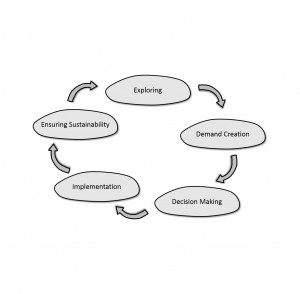The urban setting presents humanitarian actors with a complex and challenging context. The displaced often concentrate in the poorest neighbourhoods, where state capacity to deliver services and infrastructure is weak. The additional pressure on existing infrastructure can cause significant infrastructure failure with severe health consequences for the entire urban population. Urban settings require a humanitarian response that addresses both the immediate and long-term needs of the displaced and the host communities. Moreover, all interventions should support the overall sustainable development of the urban area (Linking Relief, Rehabilitation and Development (LRRD)). A collective action response can help to strengthen local resilience and capacities and to support collaboration with local authorities.
The Sphere Project Core Standards describe the essential processes for achieving the The Sphere Project Standards for humanitarian response. According to the Core Standards, a humanitarian response must ensure 1) a people-centered, rights-based approach that takes into account people’s capacity in designing an appropriate response and 2) coordination and collaboration between all organisations and authorities to ensure maximum efficiency, coverage and effectiveness. A participatory approach that includes both the displaced and the host community can increase the quality of the response and community engagement throughout the intervention.
When aiming to achieve the Core Standards, the specific needs relating to the context, target group, existing capacities and stage of the crisis need to be taken into consideration. A full, informative and impartial WASH Needs Assessmentof both the displaced and local populations’ needs should be carried out using approaches appropriate for complex urban environments.
Using the information gathered during the assessment, a list of planned activities should be created, starting with identifying the overall objectives of the intervention, the existing Emergency Preparedness and Contingency Planning and the present institutional/ infrastructural gaps. The scope and the level of detail depends on how much of the humanitarian response is left up to the humanitarian agency. Self-help initiatives and local authority-led initiatives should be promoted and incorporated into planning as they facilitate incorporating the relevant cultural, spiritual, and traditional practices (see core standard 4 in the SPHERE Handbook for assessment).
In order to ensure that the planned humanitarian response continues to meet the needs, projects should be adapted based on the outcomes of a continuous monitoring and evaluation, as well as the impact on the affected and wider populations (as stated in SPHERE Core Standard 5).
This module presents a number of participatory strategies, approaches and tools for effective and needs-based planning in Urban Settings.
Emergency Sanitation: Assessment and Programme Design
This book has been written to help all those involved in planning and implementing emergency sanitation programmes. The main focus is a systematic and structured approach to assessment and programme design. There is a strong emphasis on socio-cultural issues and community participation throughout.Includes an extensive “guidelines” section with rapid assessment instructions and details on programme design, planning and implementation.
HARVEY, P. BAGHRI, S. REED, B. (2002): Emergency Sanitation: Assessment and Programme Design. Loughborough: Water, Engineering and Development Centre (WEDC) URL [Accessed: 31.05.2019]The Sphere Handbook
This appendix of SPHERE handbook is a water supply and sanitation initial needs assessment checklist. This list of questions is primarily for use to assess needs, identify indigenous resources and describe local conditions. It does not include questions to determine external resources needed in addition to those immediately and locally available.
THE SPHERE PROJECT (2011): The Sphere Handbook. Rugby: Practical Action Publishing URL [Accessed: 19.10.2016]

